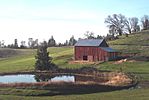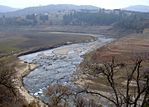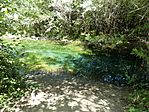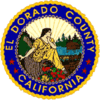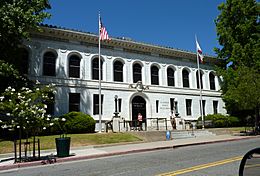El Dorado County, California facts for kids
Quick facts for kids
El Dorado County, California
|
|||
|---|---|---|---|
| County of El Dorado | |||
|
Images, from top down, left to right: A barn in El Dorado County, the shore of Lake Tahoe in Ed Z'berg Sugar Pine Point State Park, the South Fork American River running through the El Dorado hills, Marshall Gold Discovery State Historic Park
|
|||
|
|||
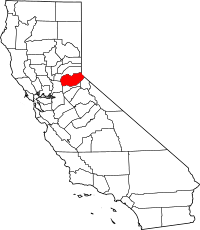
Location in the state of California
|
|||
| Country | United States | ||
| State | California | ||
| Regions | Northern California, Sierra Nevada, Gold Country | ||
| Metropolitan area | Greater Sacramento | ||
| Incorporated | February 18, 1850 | ||
| Named for | Spanish for "the golden" and El Dorado | ||
| County seat | Placerville | ||
| Largest city | El Dorado Hills | ||
| Area | |||
| • Total | 1,786 sq mi (4,630 km2) | ||
| • Land | 1,708 sq mi (4,420 km2) | ||
| • Water | 78 sq mi (200 km2) | ||
| Highest elevation | 10,886 ft (3,318 m) | ||
| Population
(2020)
|
|||
| • Total | 191,185 | ||
| • Density | 107.046/sq mi (41.331/km2) | ||
| Time zone | UTC−8 (Pacific Time Zone) | ||
| • Summer (DST) | UTC−7 (Pacific Daylight Time) | ||
| ZIP code |
95762
|
||
| Area code | 530, 916, 279 | ||
| FIPS code | 06-017 | ||
| GNIS feature ID | 277273 | ||
| Website | www.edcgov.us | ||
El Dorado County, officially the County of El Dorado, is a county in the U.S. state of California. As of the 2020 census, the population was 191,185. The county seat is Placerville.
El Dorado County is part of the Sacramento-Roseville-Arden-Arcade, CA Metropolitan Statistical Area. It is located entirely in the Sierra Nevada, from the historic Gold Country in the western foothills to the High Sierra in the east.
El Dorado County's population has grown as Greater Sacramento has expanded into the region. In the county's Lake Tahoe area, environmental awareness and environmental protection initiatives have grown along with the population since the 1960 Winter Olympics, hosted at the former Squaw Valley Ski Resort in neighboring Placer County.
History
The present-day site of El Dorado County was once home to the Maidu, Washoe, and Miwok Native American tribes, and is notable for being the site of the 1848 gold discovery that sparked the California Gold Rush. The County of El Dorado was one of California's original 27 counties created effective February 18, 1850 (the number has risen to 58 today). Its name is derived from the Spanish meaning "the gilded/golden".
The final segments of the Pony Express mail route ran through El Dorado County until its replacement with the telegraph service in 1861; U.S. Highway 50 follows the Pony Express route today.
- Local landmarks:
- Marshall Gold Discovery State Historic Park
- Confidence Hall
- Fountain-Tallman Soda Works
- John Pearson Soda Works
- Combellack-Blair House
- Rubicon Point Light
Geography
According to the U.S. Census Bureau, the county has a total area of 1,786 square miles (4,630 km2), of which 1,708 square miles (4,420 km2) is land and 78 square miles (200 km2) (4.4%) is water.
Geographic features
|
Recreation
Parks
- D. L. Bliss State Park
- Desolation Wilderness
- Eagle Falls Trailhead
- Eldorado National Forest
- Emerald Bay State Park
- Folsom Lake State Recreation Area
- Glen Alpine Springs Trailhead
- Marshall Gold Discovery State Historic Park
- Pine Hill Ecological Reserve
- Tahoe National Forest
Skiing
Racing
- Placerville Speedway
Wineries
- California Shenandoah Valley AVA
- El Dorado AVA
- Fair Play AVA
- Nello Olivo
- Sierra Foothills AVA
Demographics
The vast majority of the population lives in a narrow strip along U.S. Route 50, with the majority living between El Dorado Hills and Pollock Pines. The remainder reside in the South Lake Tahoe area, and in various dispersed rural communities.
| Historical population | |||
|---|---|---|---|
| Census | Pop. | %± | |
| 1850 | 20,057 | — | |
| 1860 | 20,562 | 2.5% | |
| 1870 | 10,309 | −49.9% | |
| 1880 | 10,683 | 3.6% | |
| 1890 | 9,232 | −13.6% | |
| 1900 | 8,986 | −2.7% | |
| 1910 | 7,492 | −16.6% | |
| 1920 | 6,426 | −14.2% | |
| 1930 | 8,325 | 29.6% | |
| 1940 | 13,229 | 58.9% | |
| 1950 | 16,207 | 22.5% | |
| 1960 | 29,390 | 81.3% | |
| 1970 | 43,833 | 49.1% | |
| 1980 | 85,812 | 95.8% | |
| 1990 | 125,955 | 46.8% | |
| 2000 | 156,299 | 24.1% | |
| 2010 | 181,058 | 15.8% | |
| 2020 | 191,185 | 5.6% | |
| U.S. Decennial Census 1790–1960 1900–1990 1990–2000 2010 2020 |
|||
2020 census
| Race / Ethnicity | Pop 2010 | Pop 2020 | % 2010 | % 2020 |
|---|---|---|---|---|
| White alone (NH) | 144,689 | 140,141 | 79.91% | 73.30% |
| Black or African American alone (NH) | 1,296 | 1,436 | 0.72% | 0.75% |
| Native American or Alaska Native alone (NH) | 1,553 | 1,273 | 0.86% | 0.67% |
| Asian alone (NH) | 6,143 | 9,024 | 3.39% | 4.72% |
| Pacific Islander alone (NH) | 261 | 276 | 0.14% | 0.14% |
| Some Other Race alone (NH) | 318 | 1,215 | 0.18% | 0.64% |
| Mixed Race/Multi-Racial (NH) | 4,923 | 11,361 | 2.72% | 5.94% |
| Hispanic or Latino (any race) | 21,875 | 26,459 | 12.08% | 13.84% |
| Total | 181,058 | 191,185 | 100.00% | 100.00% |
Note: the US Census treats Hispanic/Latino as an ethnic category. This table excludes Latinos from the racial categories and assigns them to a separate category. Hispanics/Latinos can be of any race.
2011
| Population, race, and income | |||||
|---|---|---|---|---|---|
| Total population | 179,878 | ||||
| White | 157,853 | 87.8% | |||
| Black or African American | 1,367 | 0.8% | |||
| American Indian or Alaska Native | 1,802 | 1.0% | |||
| Asian | 6,260 | 3.5% | |||
| Native Hawaiian or other Pacific Islander | 167 | 0.1% | |||
| Some other race | 6,323 | 3.5% | |||
| Two or more races | 6,106 | 3.4% | |||
| Hispanic or Latino (of any race) | 21,222 | 11.8% | |||
| Per capita income | $34,385 | ||||
| Median household income | $68,815 | ||||
| Median family income | $82,930 | ||||
Places by population, race, and income
| Places by population and race | ||||||||
|---|---|---|---|---|---|---|---|---|
| Place | Type | Population | White | Other |
Asian | Black or African American |
Native American |
Hispanic or Latino (of any race) |
| Auburn Lake Trails | CDP | 3,741 | 97.0% | 1.5% | 0.2% | 1.0% | 0.3% | 2.3% |
| Cameron Park | CDP | 16,697 | 90.8% | 6.1% | 2.2% | 0.6% | 0.4% | 15.4% |
| Camino | CDP | 1,933 | 98.7% | 0.7% | 0.3% | 0.4% | 0.0% | 3.5% |
| Cold Springs | CDP | 569 | 90.9% | 9.1% | 0.0% | 0.0% | 0.0% | 3.3% |
| Coloma | CDP | 353 | 82.4% | 17.3% | 0.3% | 0.0% | 0.0% | 20.1% |
| Diamond Springs | CDP | 11,367 | 93.6% | 2.3% | 1.3% | 0.7% | 2.1% | 9.4% |
| El Dorado Hills | CDP | 43,563 | 84.0% | 5.4% | 8.9% | 1.7% | 0.1% | 7.3% |
| Georgetown | CDP | 2,338 | 89.9% | 8.2% | 0.0% | 0.1% | 1.8% | 10.7% |
| Grizzly Flats | CDP | 923 | 97.4% | 0.0% | 0.9% | 0.0% | 1.7% | 6.7% |
| Placerville | City | 10,394 | 82.5% | 12.0% | 2.0% | 0.7% | 2.9% | 19.4% |
| Pollock Pines | CDP | 6,953 | 95.2% | 3.6% | 0.8% | 0.0% | 0.4% | 9.8% |
| Shingle Springs | CDP | 4,797 | 92.7% | 2.0% | 0.0% | 0.7% | 4.6% | 16.7% |
| South Lake Tahoe | City | 21,814 | 76.8% | 16.8% | 4.5% | 0.6% | 1.3% | 31.3% |
| Tahoma ‡ | CDP | 563 | 82.8% | 17.2% | 0.0% | 0.0% | 0.0% | 8.5% |
| ‡ Data for El Dorado County area of this CDP | ||||||||
| Places by population and income | |||||
|---|---|---|---|---|---|
| Place | Type | Population | Per capita income | Median household income | Median family income |
| Auburn Lake Trails | CDP | 3,741 | $35,522 | $79,573 | $92,308 |
| Cameron Park | CDP | 16,697 | $34,839 | $72,562 | $84,361 |
| Camino | CDP | 1,933 | $26,015 | $51,742 | $63,412 |
| Cold Springs (El Dorado County) | CDP | 569 | $30,925 | $97,576 | $99,286 |
| Coloma | CDP | 353 | $22,462 | $44,844 | $44,844 |
| Diamond Springs | CDP | 11,367 | $28,786 | $52,911 | $62,150 |
| El Dorado Hills | CDP | 43,563 | $44,920 | $115,121 | $123,816 |
| Georgetown | CDP | 2,338 | $24,117 | $52,169 | $62,614 |
| Grizzly Flats | CDP | 923 | $20,902 | $32,365 | $56,813 |
| Placerville | City | 10,394 | $26,109 | $53,385 | $66,890 |
| Pollock Pines | CDP | 6,953 | $30,826 | $54,478 | $62,760 |
| Shingle Springs | CDP | 4,797 | $34,055 | $86,786 | $89,778 |
| South Lake Tahoe | City | 21,814 | $22,958 | $41,685 | $51,538 |
| Tahoma ‡ | CDP | 563 | $32,105 | $54,286 | $63,646 |
| ‡ Data for El Dorado County area of this CDP | |||||
2010 Census
The 2010 United States Census reported that El Dorado County had a population of 181,058. The racial makeup of El Dorado County was 156,793 (86.6%) White, 1,409 (0.8%) African American, 2,070 (1.1%) Native American, 6,297 (3.5%) Asian, 294 (0.2%) Pacific Islander, 7,278 (4.0%) from other races, and 6,917 (3.8%) from two or more races. Hispanic or Latino of any race were 21,875 persons (12.1%). The largest growth in the county has come in El Dorado Hills where the population grew by 24,092 residents to a total of 42,108 since 2000.
| Population reported at 2010 United States Census | |||||||||
|---|---|---|---|---|---|---|---|---|---|
|
|
Population |
|
American |
American |
|
Islander |
races |
more races |
or Latino (of any race) |
| El Dorado County | 181,058 | 156,793 | 1,409 | 2,070 | 6,297 | 294 | 7,278 | 6,917 | 21,875 |
|
cities |
Population |
|
American |
American |
|
Islander |
races |
more races |
or Latino (of any race) |
| Placerville | 10,389 | 8,716 | 80 | 162 | 98 | 13 | 867 | 453 | 1,863 |
| South Lake Tahoe | 21,403 | 15,733 | 182 | 232 | 1,186 | 39 | 3,230 | 801 | 6,665 |
|
places |
Population |
|
American |
American |
|
Islander |
races |
more races |
or Latino (of any race) |
| Auburn Lake Trails | 3,426 | 3,190 | 6 | 28 | 36 | 5 | 45 | 116 | 208 |
| Cameron Park | 18,228 | 16,242 | 143 | 194 | 425 | 36 | 461 | 727 | 2,056 |
| Camino | 1,750 | 1,604 | 7 | 14 | 18 | 4 | 55 | 48 | 197 |
| Cold Springs | 446 | 413 | 4 | 5 | 3 | 0 | 15 | 6 | 43 |
| Coloma | 529 | 462 | 4 | 3 | 8 | 0 | 15 | 37 | 63 |
| Diamond Springs | 11,037 | 9,743 | 39 | 176 | 110 | 6 | 518 | 445 | 1,377 |
| El Dorado Hills | 42,108 | 35,089 | 615 | 196 | 3,563 | 71 | 681 | 1,893 | 3,802 |
| Georgetown | 2,367 | 2,128 | 47 | 59 | 18 | 2 | 45 | 68 | 177 |
| Grizzly Flats | 1,066 | 954 | 6 | 14 | 7 | 2 | 19 | 64 | 96 |
| Pollock Pines | 6,871 | 6,195 | 18 | 128 | 56 | 3 | 251 | 220 | 713 |
| Shingle Springs | 4,432 | 3,919 | 14 | 108 | 50 | 3 | 132 | 206 | 469 |
| Tahoma‡ | 780 | 736 | 2 | 7 | 7 | 0 | 11 | 17 | 35 |
|
unincorporated areas |
Population |
|
American |
American |
|
Islander |
races |
more races |
or Latino (of any race) |
| All others not CDPs (combined) | 56,226 | 51,669 | 242 | 744 | 712 | 110 | 933 | 1,816 | 4,111 |
| ‡ Note: these numbers reflect only the portion of this CDP in El Dorado County | |||||||||
2000
As of the census of 2000, there were 156,299 people, 58,939 households, and 43,025 families residing in the county. The population density was 91 people per square mile (35/km2). There were 71,278 housing units at an average density of 42 per square mile (16/km2). The racial makeup of the county was 89.7% White, 0.5% Black or African American, 1.0% Native American, 2.1% Asian, 0.1% Pacific Islander, 3.6% from other races, and 3.0% from two or more races. 9.3% of the population were Hispanic or Latino of any race. 14.9% were of German, 13.4% English, 10.3% Irish, 6.6% Italian and 6.6% American ancestry according to Census 2000. 90.5% spoke English and 6.5% Spanish as their first language.
There were 58,939 households, out of which 34.2% had youngsters under the age of 18 living with them, 60.1% were married couples living together, 8.9% had a female householder with no husband present, and 27.0% were non-families. 20.1% of all households were made up of individuals, and 7.3% had someone living alone who was 65 years of age or older. The average household size was 2.63 and the average family size was 3.04.
In the county, the population was spread out, with 26.1% under the age of 18, 6.8% from 18 to 24, 27.8% from 25 to 44, 26.9% from 45 to 64, and 12.4% who were 65 years of age or older. The median age was 39 years. For every 100 females, there were 99.5 males. For every 100 females age 18 and over, there were 97.3 males.
The 2000 census also states that the median income for a household in the county was $51,484, and the median income for a family was $60,250. Males had a median income of $46,373 versus $31,537 for females. The per capita income for the county was $25,560. About 5.0% of families and 7.1% of the population were below the poverty line, including 7.6% of those under age 18 and 5.0% of those age 65 or over.
Transportation
Major highways
 U.S. Route 50
U.S. Route 50 State Route 49
State Route 49 State Route 89
State Route 89 State Route 193
State Route 193- Luther Pass
Public transportation
- El Dorado Transit runs local service in Placerville and surrounding areas (as far east as Pollock Pines). Commuter service into Sacramento and Folsom is also provided.
- Tahoe Transportation District http://tahoetransportation.org/ is the transit operator for the South Lake Tahoe area. Service also runs into the state of Nevada.
Airports
General aviation airports include Placerville Airport, Georgetown Airport, Cameron Park airport and Lake Tahoe Airport.
Asbestos
Portions of El Dorado County are known to contain natural asbestos formations near the surface. The USGS studied amphiboles in rock and soil in the area in response to an EPA sampling study and subsequent criticism of the EPA study. The study found that many amphibole particles in the area meet the counting rule criteria used by the EPA for chemical and morphological limits, but do not meet morphological requirements for commercial-grade-asbestos. The executive summary pointed out that even particles that do not meet requirements for commercial-grade-asbestos may be a health threat and suggested a collaborative research effort to assess health risks associated with naturally occurring asbestos.
In 2003 after construction of the Oak Ridge High School (El Dorado Hills) soccer field, the federal Agency for Toxic Substances and Disease Registry found that some student athletes, coaches and school workers had received substantial exposures. The inside of the school needed to be cleaned of dust.
Communities
Cities
- Placerville (county seat)
- South Lake Tahoe
Census-designated places
Other unincorporated communities
- Camp Richardson
- Camp Sacramento
- Cool
- Echo Lake
- El Dorado
- Fair Play
- Garden Valley
- Greenwood
- Happy Valley
- Kyburz
- Meyers
- Outingdale
- Phillips
- Pilot Hill
- Rescue
- Somerset
- Strawberry
- Twin Bridges
Population ranking
The population ranking of the following table is based on the 2010 census of El Dorado County.
† county seat
| Rank | City/town/etc. | Municipal type | Population (2010 Census) |
|---|---|---|---|
| 1 | El Dorado Hills | CDP | 42,108 |
| 2 | South Lake Tahoe | City | 21,403 |
| 3 | Cameron Park | CDP | 18,228 |
| 4 | Diamond Springs | CDP | 11,037 |
| 5 | † Placerville | City | 10,389 |
| 6 | Pollock Pines | CDP | 6,871 |
| 7 | Shingle Springs | CDP | 4,432 |
| 8 | Auburn Lake Trails | CDP | 3,426 |
| 9 | Georgetown | CDP | 2,367 |
| 10 | Camino | CDP | 1,750 |
| 11 | Tahoma (partially in Placer County) | CDP | 1,191 |
| 12 | Grizzly Flats | CDP | 1,066 |
| 13 | Coloma | CDP | 529 |
| 14 | Cold Springs | CDP | 446 |
| 15 | Shingle Springs Rancheria | AIAN | 102 |
See also
 In Spanish: Condado de El Dorado para niños
In Spanish: Condado de El Dorado para niños


